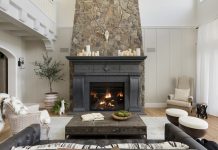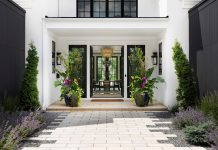
When an industrious young couple approached Jody McGuire (Midwest Home’s 2017 Emerging Talent) about designing a new project that would accommodate all of their hobbies—workshop, bike storage, micro-brewery, sauna, garden—the architect and her clients came up with a three-car garage with a sauna structure and native plant garden on the roof. The clients were thrilled. They had another request: Could the sauna, inspired by love of a Japanese teahouse, feature the traditional Japanese charred-wood technique, known as shou sugi ban?
“During the early design phase, the clients took a snowboarding trip to Japan and fell in love with the layers of beauty you can find on these mercurial black buildings, particularly when the sun highlights the wood grain,” says McGuire, of SALA Architects, referring to buildings with shou sugi ban exteriors. “Both the look and the artisanal ethic of the process suited the project. The clients were game for doing much of the finish carpentry work themselves, and for working extra hard to get long-lasting results. There’s something fun about the exterior of the sauna (traditionally a wood-burning building) being charred wood. And, let’s be honest, who doesn’t like playing with fire?”
They began with 1-inch-by-6-inch cedar boards milled into a shiplap profile, McGuire explains. Using a propane-fueled weed burner, the planks were charred on one side to a point just prior to achieving an alligator scale texture. The ash was then brushed away and the boards finished with tung oil. For a video demo of the process, go here.
Architect Katherine Hillbrand, also of SALA Architects, has incorporated shou sugi ban into projects as well, including on a sculptural home on hillside outside of Stillwater. While McGuire isn’t sure charred wood is yet a trend, “it’s certainly growing in attention and popularity in the States, and I think we’ll continue to see more of it in the near future. It also follows the current trend of black buildings.”
David Strand, principal of Strand Design, agrees. “One reason for its use is the surge in dark, moody and black houses. We all love them!” But one of his clients, while loving shou sugi ban’s appearance, opted instead to go with vertical grain Douglas fir with a black Rubio Monocoat dye and topcoat on their northern lake home. “Cost and availability were the deciding factors,” he says.
Yakisugi, referred to in the West as shou sugi ban, is a traditional Japanese method of wood preservation. By slightly charring the surface of the wood without combusting the whole piece, the wood becomes water-proof through carbonization and thus more durable. The process also protects against insects.
“The proper process is quite involved and requires not only quality material but a controlled method for evenly burning or charring the face as well as the sides and back,” Strand explains. “While the face gets the majority of the attention, the sides and back must also be treated to a certain level to prevent the material from warping and cupping and properly protect it from decay.”
Strand also believes that, in many cases, “The practical benefits that charred wood inherently has, for most people, is outweighed by the long and timely process it takes to achieve this finish. With that time and process come a rather costly per square footage cost. In areas that do not see much action the char will last an extremely long time and perform well. In areas of heavy traffic, or even upon transportation and install, it is easy to scrape or chip and is often coated with a thin sealer to minimize the black char wearing off onto things or people that may come in contact with it.”
McGuire adds that for clients considering the process, “you need either an intense commitment to strategic planning and fabrication, or an ability to make room for a finish on the upper end of the price range.” For those reasons, Strand doesn’t see shou sugi ban going mainstream.
Still, McGuire argues, “In a world of over-processed products with mystery ingredients, it is a straightforward solution, and there is some comfort in that. For some of the original reasons it was popular in Japan centuries ago—it adds fire, rot and insect resistance to wood, and has the ability to weather beautifully—combined with its DIY opportunities, charred wood is full of potential, particularly for our cabins and outbuildings.”
By Camille Lefevre






















